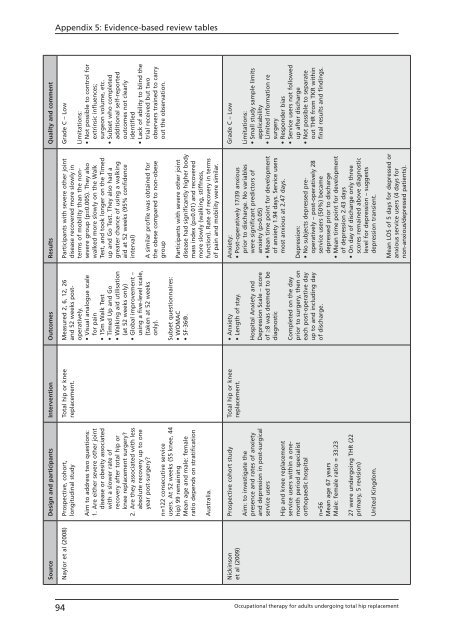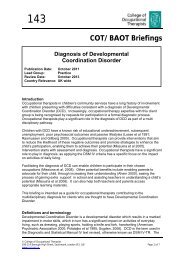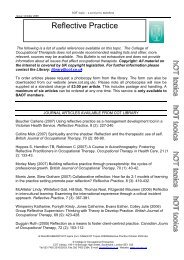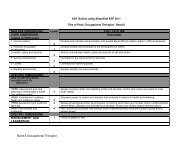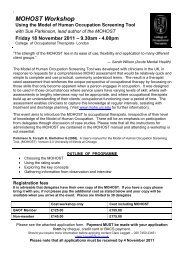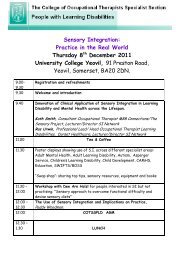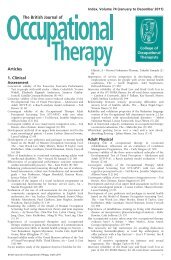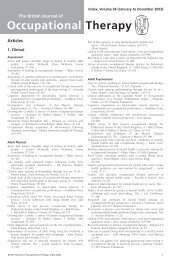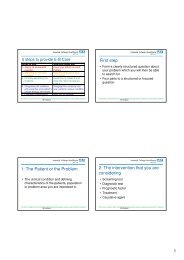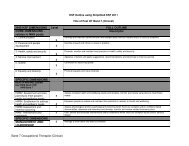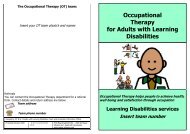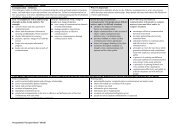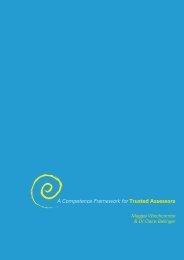Total hip replacement - College of Occupational Therapists
Total hip replacement - College of Occupational Therapists
Total hip replacement - College of Occupational Therapists
You also want an ePaper? Increase the reach of your titles
YUMPU automatically turns print PDFs into web optimized ePapers that Google loves.
Appendix 5: Evidence- based review tables<br />
Source Design and participants Intervention Outcomes Results Quality and comment<br />
Naylor et al (2008) Prospective, cohort,<br />
longitudinal study<br />
Aim to address two questions:<br />
1. Are either severe other joint<br />
disease or obesity associated<br />
with a slower rate <strong>of</strong><br />
recovery after total <strong>hip</strong> or<br />
knee <strong>replacement</strong> surgery<br />
2. Are they associated with less<br />
absolute recovery up to one<br />
year post- surgery<br />
n=122 consecutive service<br />
users. At 52 weeks (55 knee, 44<br />
<strong>hip</strong>) 99 remaining<br />
Mean age and male: female<br />
ratio depends on stratification<br />
Australia.<br />
<strong>Total</strong> <strong>hip</strong> or knee<br />
<strong>replacement</strong>.<br />
Measured 2, 6, 12, 26<br />
and 52 weeks postoperatively.<br />
• Visual analogue scale<br />
for pain<br />
• 15m Walk Test<br />
• Timed Up and Go<br />
• Walking aid utilisation<br />
(at 52 weeks only)<br />
• Global improvement –<br />
using a five-level scale,<br />
(taken at 52 weeks<br />
only).<br />
Subset questionnaires:<br />
• WOMAC<br />
• SF- 36®.<br />
Participants with severe other joint<br />
disease recovered more slowly in<br />
terms <strong>of</strong> mobility than the nonsevere<br />
group (p=0.005). They also<br />
walked more slowly on the Walk<br />
Test, and took longer on the Timed<br />
up and Go Test. They also had a<br />
greater chance <strong>of</strong> using a walking<br />
aid at 52 weeks (95% confidence<br />
interval)<br />
A similar pr<strong>of</strong>ile was obtained for<br />
the obese compared to non- obese<br />
group<br />
Participants with severe other joint<br />
disease had significantly higher body<br />
mass index (p=0.01) and recovered<br />
more slowly (walking, stiffness,<br />
function). Rate <strong>of</strong> recovery in terms<br />
<strong>of</strong> pain and mobility were similar.<br />
Grade C – Low<br />
Limitations:<br />
• Not possible to control for<br />
extrinsic influences;<br />
surgeon volume, etc.<br />
• Subset who completed<br />
additional self- reported<br />
outcomes not clearly<br />
identified<br />
• Lack <strong>of</strong> ability to blind the<br />
trial received but two<br />
observers trained to carry<br />
out the observation.<br />
Nickinson<br />
et al (2009)<br />
Prospective cohort study<br />
Aim: to investigate the<br />
presence and rates <strong>of</strong> anxiety<br />
and depression in post- surgical<br />
service users<br />
Hip and knee <strong>replacement</strong><br />
service users within a onemonth<br />
period at specialist<br />
orthopaedic hospital<br />
n=56<br />
Mean age 67 years<br />
Male: female ratio = 33:23<br />
27 were undergoing THR (22<br />
primary, 5 revision)<br />
United Kingdom.<br />
<strong>Total</strong> <strong>hip</strong> or knee<br />
<strong>replacement</strong>.<br />
• Anxiety<br />
• Length <strong>of</strong> stay.<br />
Hospital Anxiety and<br />
Depression Scale – score<br />
<strong>of</strong> ≥8 was deemed to be<br />
diagnostic<br />
Completed on the day<br />
prior to surgery, then on<br />
each post- operative day<br />
up to and including day<br />
<strong>of</strong> discharge.<br />
Anxiety:<br />
• Post- operatively 17/39 anxious<br />
prior to discharge. No variables<br />
were significant predictors <strong>of</strong><br />
anxiety (p>0.05)<br />
• Mean time point for development<br />
<strong>of</strong> anxiety 1.94 days. Service users<br />
most anxious at 2.47 days.<br />
Depression:<br />
• No subjects depressed preoperatively<br />
– post- operatively 28<br />
service users (50%) became<br />
depressed prior to discharge<br />
• Mean time point for development<br />
<strong>of</strong> depression 2.43 days<br />
• On day <strong>of</strong> discharge only three<br />
scores remained above diagnostic<br />
level for depression – suggests<br />
depression transient.<br />
Grade C – Low<br />
Limitations:<br />
• Small study sample limits<br />
applicability<br />
• Limited information re<br />
surgery<br />
• Responder bias<br />
• Service users not followed<br />
up after discharge<br />
• Not possible to separate<br />
out THR from TKR within<br />
final results and findings.<br />
Mean LOS <strong>of</strong> 5 days for depressed or<br />
anxious service users (4 days for<br />
non- anxious/depressed patients).<br />
94<br />
<strong>Occupational</strong> therapy for adults undergoing total <strong>hip</strong> <strong>replacement</strong>


